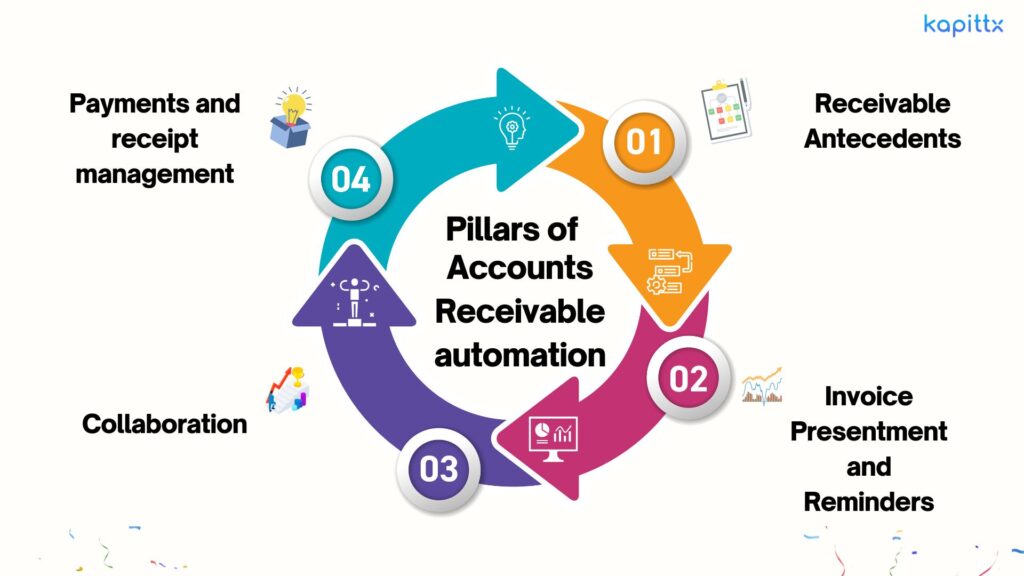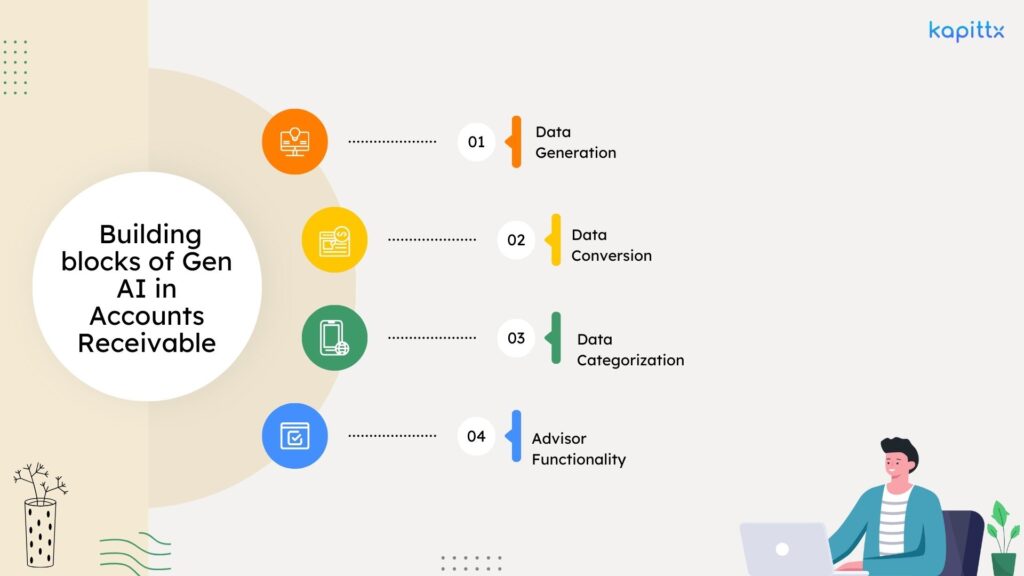Is AI the Ultimate Solution to Accounts Receivable Collections Problems
February 27, 2024AI Powered Accounts Receivable with SAP Business One to improve your cash flow
March 12, 2024The advent of Generative AI (Gen AI) heralds a paradigm shift in the landscape of Finance and Accounting (F&A). Much like the introduction of spreadsheets as a product innovation decades ago, finance professionals were quick to embrace and derive immense benefits from the use of spreadsheets.
Gen AI in Finance and Accounting emerges as a potential game-changer, poised to revolutionize traditional practices within the realm of F&A and invoice payments. However, for this potential to be realized, CFOs must demonstrate openness to experimentation, allowing themselves to explore the tangible impact of Gen AI in Finance and Accounting functions.
Embarking on this journey necessitates a focused exploration of Gen AI’s applicability, particularly within accounts receivable management and invoice payments. By delving into this domain, CFOs can gain firsthand insight into the transformative power of Gen AI in Accounts Receivable. As with any strategic business investment, it is prudent to assess the anticipated returns and the timeframe within which these benefits can be realized.
In essence, embracing Gen AI in accounts receivable and invoice payments represents not only a technological advancement but also a strategic imperative for forward-thinking finance leaders. By embracing innovation and fostering a culture of experimentation, organizations can unlock unprecedented efficiency, agility, and competitive advantage in the ever-evolving landscape of finance and accounting.
How Can Gen AI Revolutionize Your Accounts Receivable Process?
Irrespective of the organization, to ensure optimal efficiency within the accounts receivable function and to explore the potential of integrating Gen AI powered Accounts receivable, it is essential to adopt a strategic approach centered around four key building blocks. These pillars serve as the foundation for effective management and innovation in accounts receivable:

1. Receivable Antecedents :
This encompasses the meticulous orchestration of all preliminary tasks necessary to establish a receivable. From the initial engagement with clients to the negotiation of terms, to the careful documentation of agreements, each step in this process demands precision and foresight. Building strong receivables antecedents lays the foundation for smooth transactions, timely invoice payments and ensures a robust financial framework
They include:
- Customer Onboarding: Accurate customer data collection, credit checks, and setting credit limits.
- Sales Order Processing: Efficiently converting orders into invoices.
- Contractual Agreements: Clear terms and conditions regarding payment terms, discounts, and penalties.
- Order Fulfillment: Ensuring timely delivery of goods or services.
- Timely Invoicing: Generate invoices promptly after goods/services are delivered.
- Clear and Accurate Invoices: Ensure clarity, itemization, and correct pricing.
2. Invoice Presentment and Reminders:
In the dynamic landscape of revenue management, the presentation of invoices holds paramount importance. It transcends beyond mere documentation; it embodies the essence of your transactions, encapsulating the value exchanged with your clients. Your approach to invoice presentment and invoice payments is characterized by clarity, accuracy, and timeliness. Moreover, one need to recognize the strategic significance of reminders in facilitating prompt invoice payments. Through proactive communication and gentle nudges, you endeavor to uphold transparency, nurture client relationships, and optimize cash flow dynamics.
This step involves creating and delivering invoices to customers:
- Multiple Channels: Offer electronic and paper-based invoice delivery to facilitate invoice payments.
- Standard Payment Reminder Schedule:
o Set a consistent schedule for sending payment reminders. This helps maintain clarity and predictability for both you and your clients.
o Send reminders before the due date to gently prompt clients to pay on time.
o Issue reminders close to the actual due date to emphasize the urgency.
• Personalized Reminders:
o Customize your reminders to suit each client. Address them by name and include relevant details.
o Personalization shows that you value the relationship and encourages prompt payment.
• Politeness and Professionalism:
o Maintain a polite and professional tone in your reminders.
o Avoid threatening language or negativity that could harm the client relationship.
o Clearly state the purpose of the reminder and the essential details, such as the invoice number, amount due, and due date.
3. Collaboration :
Collaboration lies at the heart of your approach, both externally with your valued customers and internally among your team members and departments. Externally, effective collaboration involves understanding your clients’ needs, communicating transparently, and working together to resolve any issues or discrepancies promptly. Internally, collaboration ensures alignment across functions, streamlines processes, and maximizes efficiency, ultimately leading to superior customer service and satisfaction.
- Effective communication is crucial:
- Customer Communication: Regular follow-ups, addressing queries, and resolving disputes.
- Internal Coordination: Collaboration between sales, finance, and customer service teams.
- Dispute Resolution: Swiftly address any discrepancies.
4. Payments and receipt management :
Efficient management of invoice payments and receipts is essential for maintaining cash flow and optimizing financial performance. This includes implementing secure and convenient payment channels, diligently tracking incoming payments, and promptly reconciling accounts. By prioritizing invoice payments and receipt management, you can minimize delays, mitigate risks, and ensure the stability and resilience of our financial ecosystem.
- Efficient handling of incoming invoice payments:
- Payment Channels: Accept various methods (credit cards, bank transfers, etc.).
- Reconciliation: Match payments with outstanding invoices.
- Cash Application: Apply payments accurately to the correct accounts.
What are the building blocks of Gen AI in Accounts Receivable?
Overall, Gen AI in accounts receivable encompasses a wide range of capabilities making it a versatile tool for various applications across different domains. A few of the core building blocks are –

- Data Generation: Gen AI In accounts receivable, can generate synthetic data to augment existing datasets used for training predictive models. For example, it can create simulated customer invoice payments histories, including variations in payment amounts, frequencies, and timing. This synthetic data allows organizations to train their models more comprehensively, improving the accuracy of predictions regarding future payment behavior.
- Data Conversion: Gen AI in accounts receivable can facilitate the conversion of data between different formats in the accounts receivable process. For instance, it can automatically convert paper-based invoices into digital formats by extracting relevant information such as invoice numbers, amounts, and due dates using optical character recognition (OCR) technology. This conversion streamlines the invoicing process, reducing manual effort and minimizing errors.
- Data Categorization: Gen AI in accounts receivable, can categorize transactions based on various criteria such as invoice payment methods, customer segments, or invoice statuses. For example, it can automatically classify incoming invoice payments as cash, checks, or electronic transfers, allowing finance teams to track payment trends and reconcile accounts more efficiently. By categorizing transactions accurately, Gen AI powered accounts receivable enhances data organization and facilitates deeper insights into receivables management.
- Advisor Functionality: Gen AI in accounts receivable serves as an intelligent advisor by providing actionable insights and recommendations based on analyzed data. For example, it can identify patterns of late invoice payments or discrepancies in invoicing that may indicate potential issues with specific customers or billing processes. By alerting finance teams to these anomalies, Gen AI powered accounts receivable enables proactive intervention to mitigate risks and optimize cash flow management.
Overall, Generative AI enhances the efficiency and effectiveness of accounts receivable operations by generating data, facilitating data conversion, categorizing transactions, and providing intelligent advisory support. By leveraging Gen AI capabilities, organizations can streamline receivables management processes, improve decision-making, and ultimately enhance financial performance.
